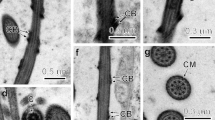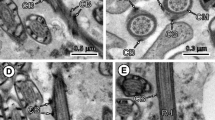Summary
The process of cell division during spermatogenesis in Taenia hydatigena followed the general pattern reported by Rybicka (1966) for other cestodes. Sixty-four spermatozoa were formed from each primary spermatogonium after a series of five nuclear divisions. During spermiogenesis, changes in the organisation of sperm tail cytoplasm were evident with four distinct regions along the length of the spermatozoon being distinguishable. The axoneme which was normally single in each sperm tail, had the typical 9 plus 1 structure found in platyhelminths. Nuclear material in the mature spermatozoon was arranged spirally around the axoneme.
Similar content being viewed by others
References
Andre, J.: Contribution à la connaissance du chondriome. J. Ultrastruct. Res., Suppl. 3, 185 pp. (1962).
Bonsdorff, C.H. von., Tellka, A.: The spermatozoon flaggella in Diphyllobothrium latum (fish tapeworm). Z. Zellforsch. 66, 643–648 (1965).
Fawcett, D.: Cilia and flagella. In: The Cell (J. Brachet, A.E. Mirsky, eds.), II, p. 217–298. New York and London: Academic Press 1941.
Featherston, D.W.: Taenia hydatigena: I. Growth and development of adult stage in the dog. Exp. Parasit. 25, 329–338 (1969).
— Taenia hydatigena: II. Evagination of cysticerci and establishment in dogs. Exp. Parasit. 29 242–249 (1971).
Franke, W.W., Krien, S., Brown, R.M.: Simultaneous glutaraldehyde-osmium tetroxide fixation with post-osmication. Histochemie 19, 162–164 (1969).
Hendelberg, J.: Paired flagella and nucleus migration in the spermiogenesis of Dicrocoelium and Fasciola (Digenea, Trematoda). Zool. Bidr. Uppsala 35, 569–588 (1962).
Karnovsky, M.L.: A formaldehyde-glutaraldehyde fixative of high osmolality for use in electron microscopy. J. Cell Biol. 27, 137A-138A (1965).
Kretser, D.M. de: Ultrastructural features of human spermiogenesis. Z. Zellforsch. 98, 477–505 (1969).
Morseth, D.J.: Sperm tail fine structure of Echinococcus granulosus and Dicrocoelium dendriticum. Exp. Parasit. 24, 47–53 (1969).
Pashchenko, L.F.: Development of the later stages of spermatogenesis in Taeniarhynchus saginatus (Goeze, 1782). Dokl. Akad. Nauk SSSR 163, 269–271 (1965).
Phillips, D.M.: Exceptions to the prevailing pattern of tubules (9+9+2) in the sperm flagella of certain insect species. J. Cell Biol. 40, 28–43 (1969).
Reynolds, E.S.: The use of lead citrate at high pH as an electron-opaque stain in electron microscopy. J. Cell Biol. 17, 208–212 (1963).
Rosario, B.: An electron microscope study of spermatogenesis in cestodes. J. Ultrastruct. Res. 11, 412–427 (1964).
Rybicka, K.: Embryogenesis in cestodes. In: Advances in parasitology, Vol. 4, p. 107–186. B. Dawes ed. New York and London: Academic Press 1966.
Sato, M., Oh, M., Sakoda, K.: Electron microscopic study of spermatogenesis in the lung fluke (Paragonimus miyazakii). Z. Zellforsch. 77, 232–243 (1967).
Author information
Authors and Affiliations
Rights and permissions
About this article
Cite this article
Featherston, D.W. Taenia hydatigena. Z. F. Parasitenkunde 37, 148–168 (1971). https://doi.org/10.1007/BF00259555
Received:
Issue Date:
DOI: https://doi.org/10.1007/BF00259555




